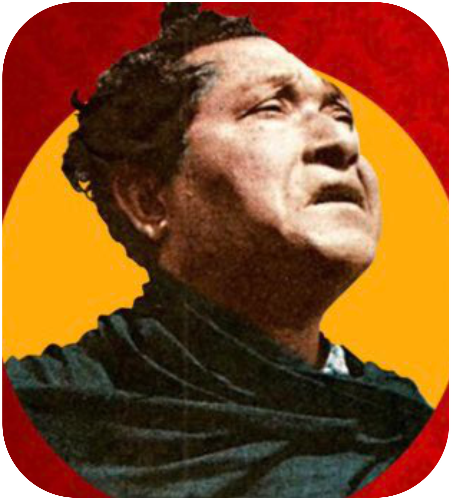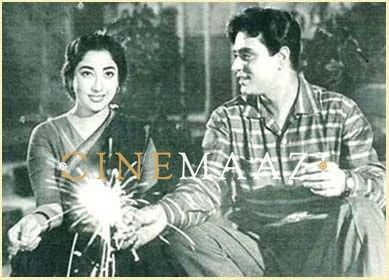Bishnuprasad Rabha

Subscribe to read full article
This section is for paid subscribers only. Our subscription is only $37/- for one full year.
You get unlimited access to all paid section and features on the website with this subscription.
Not ready for a full subscription?
You can access this article for $2 , and have it saved to your account for one year.
- Born: 31 January 1909 (Dacca, Bengal Presidency, British India; now in Dhaka, Bangladesh)
- Died: 20 June 1969 (Tezpur, Assam, India)
- Parents: Gethi Mech and Raibahadur Gopal Chandra Rabha
- Spouse: Mohini Rabha
A revered figure in the cultural history of Assam, Bishnuprasad Rabha was an artist, singer, lyricist, music composer, litterateur, and architect. He is also a director and actor known for Siraj (1948) and Era Bator Sur (1956). Dubbed Kalaguru (the master of the arts) by the Assamese people, he was also called Sainik Silpi (soldier artist) by the Marxists on account of his active participation in the armed struggle led by the Revolutionary Communist Party of India. A progressive-minded writer and cultural activist, his intervention added fresh meaning and substance to the existing tradition of Assamese literature. One of the most dominant figures to contribute to Assam's cultural and political fields, his extraordinary versatility endeared him to the Assamese people. An advocate of the people’s cultural movement, he drew heavily from the various genres of classical and folk cultural traditions. Motivated by the political ideology of Marxism, he participated in the political field, both as a student and a mature citizen, working to bring much-needed change in the social system. A believer in the need for awareness of other cultures, views, and religions, he advocated for a world community. He is remembered as the musical and artistic genius who transcended man-made barriers to unite diverse communities
Born into a financially sound family on 31 January 1909 in Dacca, Bengal Presidency, British India (now in Dhaka, Bangladesh), his father Raibahadur Gopal Chandra Rabha, who was in the British police, passed away while Bishnuprasad was still in his childhood. However, his interest in and passion for the rich cultural heritage had already been sparked by his parents; in time, his repertoire of experience and intensive knowledge of the different folk traditions of India’s North East would help fashion his musical sense. He was also considerably influenced by the iconic figures of Bengal of those times – Rabindranath Tagore and Sarat Chandra Chattopadhyay.
His foray into public life began with his participation in the anti-colonial student movement; in 1929, he would go on to take charge as the general secretary of the students’ union of Ripon College. This would become the turning point of his political life, as he became influenced by Mahatma Gandhi. A year later, he actively participated in the Independence movement of 1930 (the civil disobedience movement) in Calcutta, as a result of which he was compelled to leave Ripon College. Joining Victoria College of Coochbehar, he was again expelled for irking the British. From Tezpur, where he had fled, he began his activities.
His interest in the performing arts blossomed alongside. Visiting Kashi (Varanasi) in the latter part of 1940, he undertook the study of the Kamrupi dance form. At the ‘Rabha Divas’ organised at Kashi University by the dramatic association president Satish Kalekar and Ramoni Sarmah, he performed a dance based on Krishna Leela, Dasavatar, and Tandava, earning special praise from the university’s vice-chancellor Sarvepalli Radhakrishnan.
Following the Gandhian ideology of non-violence during his student days, he played an active role in the freedom activities initiated by the Congress. Growing disenchanted by the party’s apparently cavalier attitude towards the desires of farmers and workers, he was slowly drawn towards communist ideology. Formally accepting the membership of the Revolutionary Communist Party of India (RCPI) in 1946, he began penning songs and poems supporting communism and revolution, as well as nationalism and liberal humanism.
His communist ideology found reflection in his stories, plays, and novel, including ‘Hiyar Pung’, ‘Sonpahi’, ‘Sapon Kuwali’, ‘Kuri Bachar Jail’, ‘Mamir Har’, ‘Banua Panchyat’, and ‘Krishak’. Examining contemporary society, he grew increasingly aware of the exploitation and oppression of the poor by the powerful in society, even as he realised the upcoming consequences of the country’s independence. Travelling to different parts of Assam, he lived a nomadic life, trying to inspire people to aspire towards a classless society and awaken them to the pathetic conditions of people in Assam. His personal experiences of Assamese society also found reflection in his literary creations. The majority of his literary creations conveyed the failure of existing political and economic systems to give security to the poor class.
Dissatisfied with the socio-economic and political condition of Assam, he even changed parties and left his home. In exile, he spread socialist ideas among the working class, farmers and ethnic communities. The government came down heavily on the path of revolution that many of them chose.
In 1957, he, along with Bhabananda Dutta, jointly contested the general elections representing the socialist party from the Kokrajhar Parliamentary Constituency; they would be defeated by the Congress contestants Dharanidhar Basumotary and Rani Manjula Devi. This proved that his ideology of socialism had not found resonance with the people of Assam. Ten years later, he was elected from Tezpur legislative constituency, where he nurtured his interest in art and culture.
An established singer, he had learned the Borgeet of Shrimanta Shankar Deva and contemporized the genre. His hundred-plus songs comprised a new Assamese genre collectively known as Bishnu Rava Sangeet. His compositions such as Xurore deulore, Para jonomor khubho logonor, and Bilote halise reflect a range of themes, including tributes to Mother Nature, the exploitation of the peasant masses, and the revolts of the workers at tea estates. He also translated the famous song of Revolution Internationale by Eugène Pottier into Assamese. His paintings are still preserved in his residence at Tezpur.
A gifted actor, he would also perform dramas at Baan theatre of Tezpur, regarded as one of the oldest cultural activity centres of Assam. Despite having a wide network, he chose not to pursue commercial acting in Calcutta or Bombay, but stayed on in Assam to use his talent to educate the masses.
Coming to his work in film, he had assisted in the making of the first Assamese film Joymoti (1935), by Jyoti Prasad Agarwala. A recognised film director, he directed the drama film Siraj (1948) along with Phani Sarma. While Sarma featured in the leading role, Rabha composed the music of the film. The film’s cast included Anupama Bhattacharya, Bhupen Hazarika, Mohini and Nishan. In 1956, he acted in the Bhupen Hazarika directorial Era Bator Sur, alongside a cast that included Phani Sarma, Eva Achaw, Anil Das, Preetidhara, Balraj Sahni and Bijoy Shankar.
Bishnuprasad Rabha passed away on 20 June 1969 in Tezpur, Assam. The Kalaguru Bishnu Rabha award was instituted by the state government of Assam in his honour for achievements in the world of culture and music. The Bishnu Rabha Smriti Udyan, a memorial park on the banks of the Brahmaputra near Tezpur, was set up in his honour.







.jpg)



